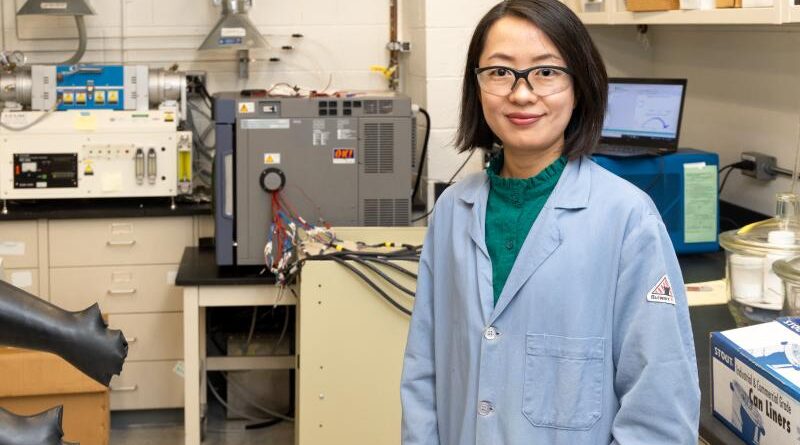Chelsea Chen: Breaking Barriers In Energy Storage
For those who dream of driving their electric vehicle long distances to see the world’s largest ball of twine, Chelsea Chen is dedicated to making it possible.
Chen, a polymer physicist at the Department of Energy’s Oak Ridge National Laboratory, is studying ion transport in solid electrolytes that could help electric vehicle battery charges last longer.
“The challenge with current EVs is to further increase driving range, and that means higher energy density,” said Chen. “This requires revolutionary design of the battery chemistry.”
To address this, Chen is researching solid polymer electrolytes.
“Solid-state electrolytes are the key to higher energy density. Polymers encounter both the cathode and the anode in EV batteries. Understanding and optimizing the structure and properties at the interface is the key to improving the performance of solid-state batteries.”
Just the ‘FaCTs’
Chen is a staff researcher with the Fast and Cooperative Ion Transport in Polymer-Based Materials, or FaCT, center, one of 16 newly funded DOE Energy Frontier Research Centers that partner mainly with universities and national labs around the country working to solve pressing scientific challenges at the forefront of fundamental energy science research. FaCT researchers aim to build a model of ion transport in polymers that will inform the future design of energy storage and conversion materials, such as battery electrolytes.
Chen’s research at ORNL focuses on developing solid-state batteries and understanding ion transport in polymer-ceramic composite electrolytes and at electrolyte/electrode interfaces.
Popular high energy density designs use a lithium metal anode. However, lithium reacts readily with liquid electrolytes in current lithium-ion batteries, leading to fire safety concerns.
Solid-state electrolytes could offer a solution, and pairing them with a high-voltage cathode and a lithium metal anode leads to increased energy density.
The path to now
Chen was born in northeast China. Her favorite subject in high school was chemistry. “I was always interested in the titration experiments, seeing how one material reacts with another,” she said.
As an undergraduate student at Shanghai Jiao Tong University in China, Chen was surrounded by polymer experts. “They have a big polymer program housed in their chemistry department,” said Chen. “I worked with so many professors who specialized in polymers.”
Chen got her doctorate in macromolecular science and engineering from the University of Michigan, with a dissertation on controlling nanoparticles’ spatial distribution within a thin film polymer host. She completed postdoctoral studies at the University of California, Berkeley, and Lawrence Berkeley National Laboratory, studying the structure of polymers with electron microscopy and small-angle X-ray scattering.
Chen has built her career around understanding the structures, properties and behaviors of polymers. Before joining ORNL’s Materials Science and Technology Division in 2017, Chen was a senior chemist at Dow Chemical. There, she focused on developing polymer dielectric films with increased thermal conductivity and mechanical flexibility for semiconductor applications.
Although she was working in her field, Chen realized her passion was research and development, which is not necessarily a priority in industry.
“I’ve always wanted to do more fundamental research, which you cannot do in the commercial sector,” Chen added. In 2017, she went back to her national laboratory roots. “I wanted to work in an institution where R&D is the focus.”
Chen has welcomed the environment change and enjoys the benefits of working at a national lab.
“The number one difference is that here the science output is the most important thing,” said Chen. Putting her passion into publishing research performed at ORNL earned Chen an American Chemical Society Young Investigator Award in 2022.
She also appreciates the multidisciplinary collaboration. “University work is very siloed,” said Chen. “My favorite thing about the lab is that I can access an expert in any field if I have a problem or question. They are all right here.”
The future of plastics
While Chen collects her data, she is also interested in what happens to polymer products in general, not just electrolytes for EV batteries.
“We should really be reusing polymers for something else instead of discarding them into the ocean,” said Chen, speaking of the packaging industry and consumer plastics. “Unfortunately,” she said, “it’s cheaper to make new ones instead of recycling.”
To improve the sustainability of EV batteries, manufacturers are interested in recycling spent batteries to recapture materials like lithium, cobalt and nickel. Chen thinks that polymers deserve the same recycling consideration.
Chen’s work advances sustainable chemistry through recycling and upcycling — think shoes made of water bottles. She hopes research like hers will help public and private sectors consider and address end-of-life issues in polymer design.
The DOE Office of Energy Efficiency and Renewable Energy and the DOE Office of Science fund Chen’s work. Her research often relies on the Spallation Neutron Source and the Center for Nanophase Materials Sciences, DOE Office of Science user facilities at ORNL.
UT-Battelle manages ORNL for DOE’s Office of Science. The single largest supporter of basic research in the physical sciences in the United States, the Office of Science is working to address some of the most pressing challenges of our time. For more information, please visit energy.gov/science.
By Christy White. Courtesy of Oak Ridge National Laboratory.
Have a tip for CleanTechnica? Want to advertise? Want to suggest a guest for our CleanTech Talk podcast? Contact us here.
Latest CleanTechnica.TV Video

CleanTechnica uses affiliate links. See our policy here.

